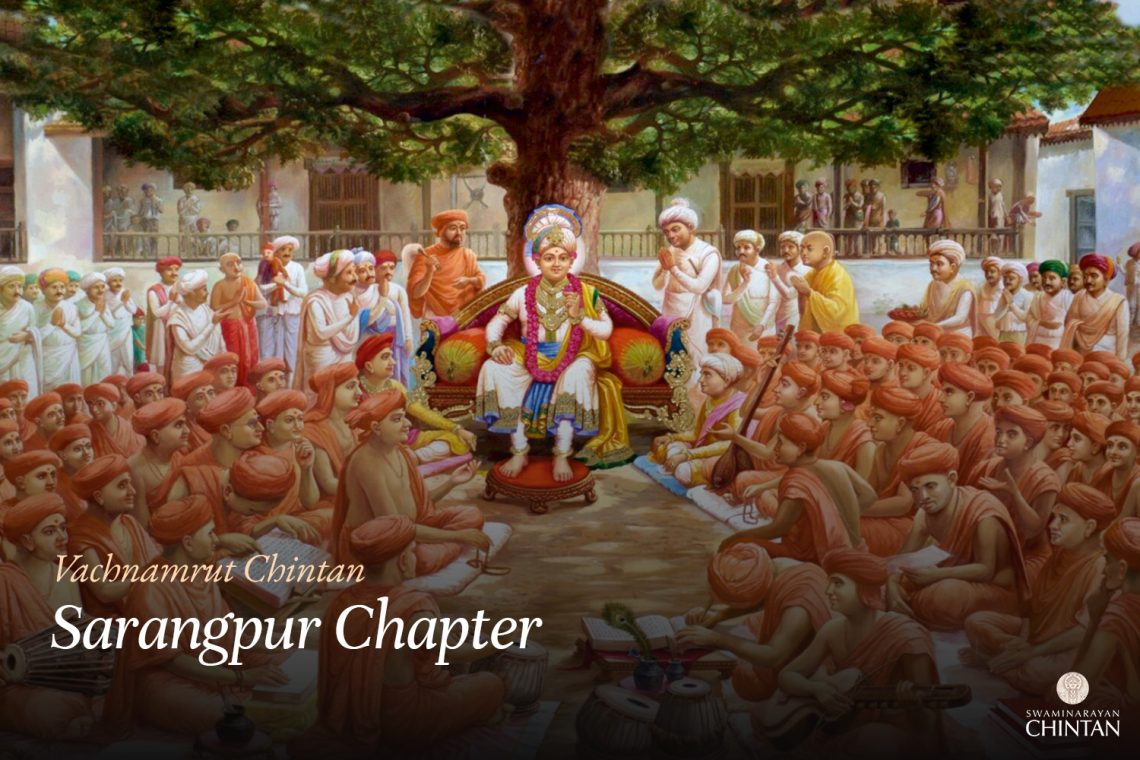Central Insights:
- Eradication of Vasana and the Secret of Darshan, the Nature of Anvay and Vyatirek.
Main Points:
- Understanding the greatness of God thoroughly leads to the eradication of Vasana.
- The intensity of Darshan embeds deep impressions in the soul, fostering love for God accordingly.
Commentary:
In this Vachanamrut, Muktanand Swami asked Maharaj a question regarding the powerful single method for eradicating Vasana (worldly desires or impressions). Maharaj replied that Bhakti (devotion) accompanied by the knowledge of God’s greatness is the ultimate means to eradicate all Vasana. Initially, Maharaj explains the general methods for Vasana eradication: 1. Having faith, 2. Trust in the words of God and His devotees, and 3. love for God. These factors drive away Vasana. Enthusiasm for Bhakti, Dhyan (meditation), and Upasana (worship) reflects one’s faith. As one grows closer to God, faith transforms into trust, which is strengthened through experiences and convictions in devotion and Upasana. As trust grows, noble feelings intensify, leading to deep- seated love for God, eradicating Vasana at its roots. These are the means to eradicate Vasana.
Maharaj also stated that even if one possesses just Bhakti with the knowledge of God’s greatness, without much faith, trust and love will naturally develop. The core reason is the greatness of God. Thus, if one comprehends this greatness, even non-existent virtues will emerge, whereas, without it, even existing virtues will eventually fade. Bhakti accompanied by the knowledge of God’s greatness is a potent means for eradication of Vasana.
Mahatmya (Greatness) refers to comparative knowledge. For example, recognizing rice as Basmati rice is specific knowledge, which indicates its special attributes or greatness. Similarly, God’s unique attributes compared to others constitute His greatness. Basic knowledge accompanied by specific knowledge is considered Mahatmya. Scriptures like Upanishads and Brahmasutras extol God’s greatness. For instance, ‘सत्यं ज्ञानम् अनन्तम्’ — satyam jñānam anantam brahma; describes God as infinite, beyond anything else. Another example is,‘जन्माद्यस्य यतः’— janmādyasya yataḥ; indicating that the creation of the universe is under God’s control, underscoring His greatness. Differentiating God even from entities of the same category highlights His excellence. For example, recognizing Basmati rice among different types of rice illustrates its greatness.
In Vach.G.L.39, points for understanding God’s greatness include His distinctiveness in happiness, prosperity, power, skills, etc. Recognizing and experiencing these attributes aids in understanding God’s greatness, which serves as a substantial means to eradicate Vasana.
Muktanand Swami further inquired about the significance of Darshan, chanting God’s name, and physical contact with God – whether they hold significance solely for devotees or for all beings. Maharaj explained that the intensity of Darshan and other experiences influences the depth of impressions on the soul, thereby enhancing love for God.
Maharaj says: When one has Darshan of Bhagwan with a concentrated mind and engages both the mind and soul in the present moment, that Darshan remains unforgettable, even if one tries to forget it. When the mind is united with the soul during Darshan, it results in a profound experience. Maharaj explains that just as the Gopis expressed to Bhagwan, “Oh Bhagwan! Since the day we touched Your feet, all worldly pleasures have seemed like poison to us,” this intense experience occurred because their mind, soul, and senses were fully immersed in Bhagwan’s Darshan. This did not happen simply because they were devotees. If others can engage their mind, soul, and senses similarly, they too can experience the exceptional greatness and magnificence of Bhagwan. However, if a devotee lacks intensity and does not unite the mind and soul during Darshan, the exceptional experience does not occur. Hence, Maharaj stated in Vach. Sarangpur 3 that even if one performs Darshan for a lifetime, it does not lead to a special experience. Indeed, even if one does Darshan for a million years, it will not yield the desired result. Therefore, Maharaj emphasizes that the nature of Darshan is distinct.
It is important to clarify the difference between intensity and hastiness. Hastiness results from the increase of Rajas gun, which brings instability and lack of direction, thus lacking the capacity for focused aim. On the other hand, intensity is driven by Mahatmya (greatness). It involves extreme degree of focus, speed but also precision and clarity of purpose. Therefore, only when Darshan is done with the engagement of the mind does it yield its true fruit. Maharaj says that even if worldly experiences are enjoyed with the mind fully involved, they are never forgotten. Similarly, if Bhagwan’s Darshan is performed in this manner, how can it be forgotten? Hence, Darshan with mental engagement is considered true Darshan. Otherwise, even if Darshan occurs, it is as if it did not happen because, without the mind’s presence, it is certain that the Darshan will be forgotten. Therefore, when Darshan is performed with understanding of the greatness and with the mind fully engaged, it yields the true results described in the scriptures. For others, it is merely a secondary effort.
A doubt may arise that Bhagwan’s Darshan, touch, name, etc., are the same for both devotees and non-devotees. If that were the case, there would be no distinction between devotees and non-devotees, and the devotees’ faith in performing Bhakti would diminish.
The resolution to this is that there is never an equality between devotees and non-devotees. Although there may be differences in the intensity and speed with which the senses and mind operate, the devotee’s ego and sense of mamata (attachment) are related to Bhagwan. Since the devotee is connected to Bhagwan, there is a spiritual bond within the soul. Based on this bond, Bhagwan ensures their liberation. In contrast, non-devotees lack this spiritual connection or sense of attachment to Bhagwan. The results they achieve are the production of punya (merit) and the creation of strong samskars (impressions) for performing Bhakti in future births. If very strong impressions are formed, they too will become devotees and reach Bhagwan in this very life. Otherwise, through secondary efforts, they will reach Bhagwan in future births. Additionally, as a devotee’s daily practice of Bhakti strengthens their impressions, their intensity and speed will increase, and through such practice, they will eventually develop strong faith. As stated in the Gita (4:38), “By practicing over a long period, the faithful attain this knowledge.” The same will naturally be achieved by those who practice over time. Therefore, there is no need for doubt. What is needed is to increase the intensity.
In this Vachanamrut, Swayamprakashanand Swami asked a question: How is Jeev Anvay (identical)? And how is it Vyatirek (distinct)? How is Ishwar Anvay? And how are they Vyatirek? How is Aksharbrahm Anvay? And how is it Vyatirek? How to know Purushottam Bhagwan as Anvay? And how to know Him as Vyatirek? Maharaj replied that knowing the nature of the Jeev as subject to birth and death is understanding it as Anvay, while recognizing the Jeev as impenetrable and imperishable is understanding it as Vyatirek. That is, to consider the emotions and feelings of the body as belonging to the Atma (soul) and to experience happiness or sorrow is called Anvay. When one considers oneself separate from bodily feelings and remains detached from the body’s emotions, that is called Vyatirek.
Ishwars also have three bodies. They are great, and while they do not have the intense emotions like the Jeev, they have attachments such as the sense of doership. Hence, considering them along with the three bodies is understanding them as Anvay, and considering them separate from these three bodies is understanding them as Vyatirek. When knowing the Anvay nature of the Akshar, which is the inspirer of the Jeevs, Ishwars, and all deities, one understands it as distinct from all, where only Maharaj remains, and nothing else, this is understanding it as Vyatirek. Although Paramatma resides as a witness in the hearts of the Jeev, Ishwar, and Muktas, their limitations do not affect Him. This is the Anvay nature of Paramatma. Moreover, knowing him as beyond Akshar His own form transcends in His divine abode is understanding His Vyatirek nature.
Glossary
| Anvay – Identical connection |
| Vyatirek – Distinct separation |
| Vasana – Worldly desires The latent impressions or desires in the mind that draw the individual towards worldly attachments and pleasures. |
| Bhakti – Devotion Loving and selfless worship of God. |
| Mahatmya – Understanding the supreme glory and significance of Bhagwan, leading to increased faith and devotion. |
| Darshan – Vision of God |
| Dhyan – Meditation Deep concentration on Bhagwan’s divine form. |
| Upasana – Worship and devotion The practice of deep meditation and attachment to Bhagwan. |
| Mamata – Attachment |
| Samskar – Spiritual impressions |
| Jeev – Soul The individual living entity, distinct from the body and mind, that experiences life and karma. |
| Ishwar – God A term for the divine, sometimes used interchangeably with Paramatma or Bhagwan. |
| Aksharbrahm – The eternal and unchanging divine realm The supreme divine existence or state that is beyond the material world, often referenced in Swaminarayan philosophy. |
| Purushottam Bhagwan – Supreme God |
| Rajas Gun – Mode of passion |
| Intensity vs Hastiness – Difference in approach Intensity is driven by faith and focus, whereas hastiness comes from instability and lack of clarity. |
| Gopis – Devotees of Krishna The cowherd women of Vrindavan known for their unparalleled love for Krishna. |
| Punya – Good Deeds |

